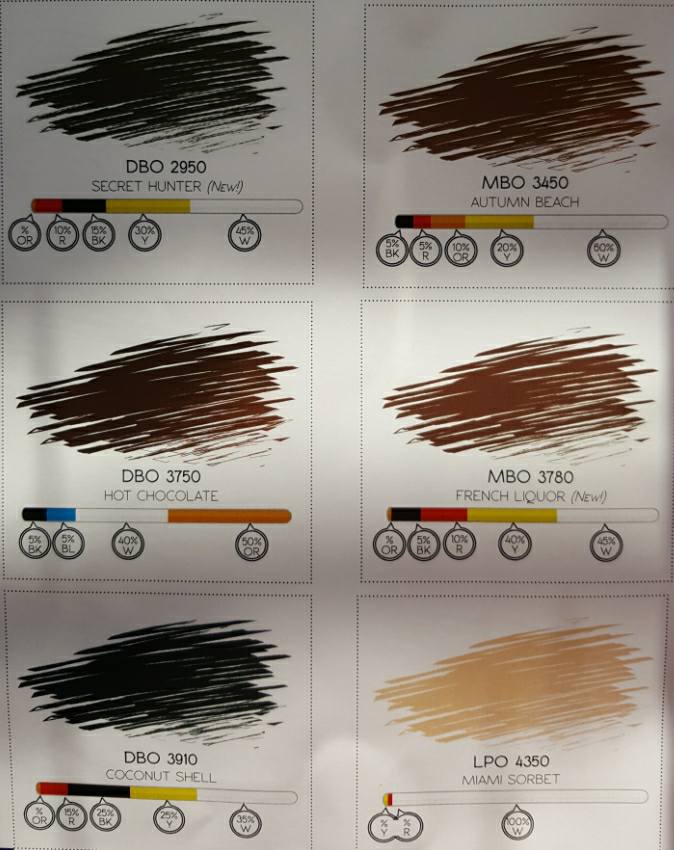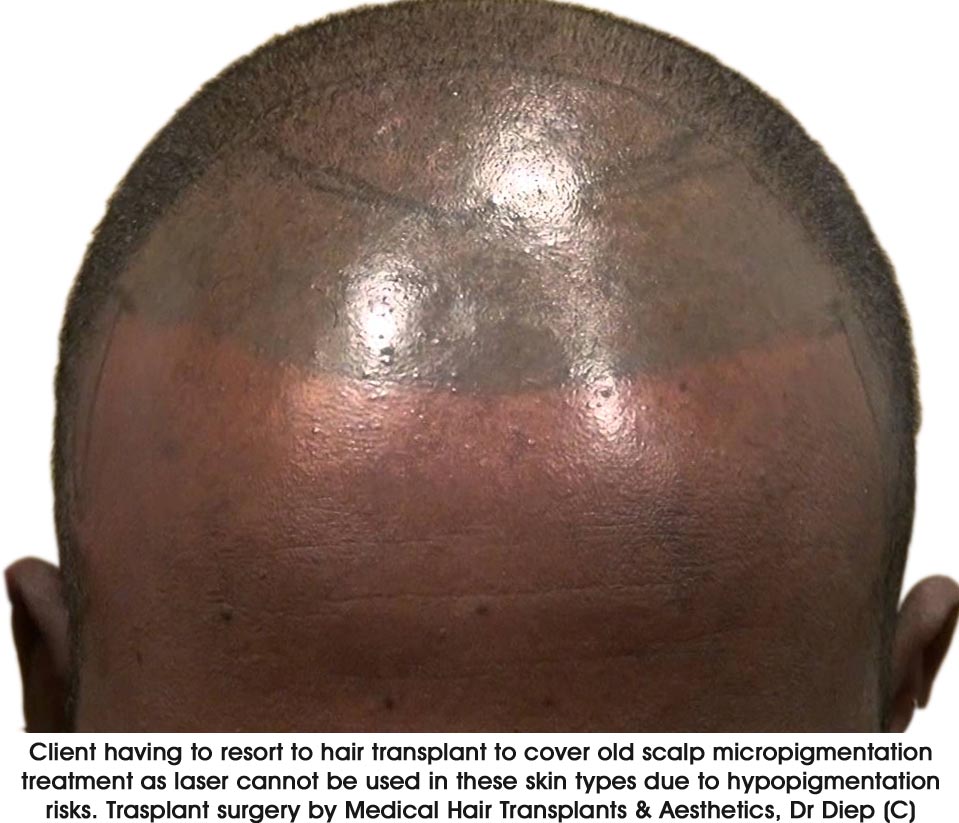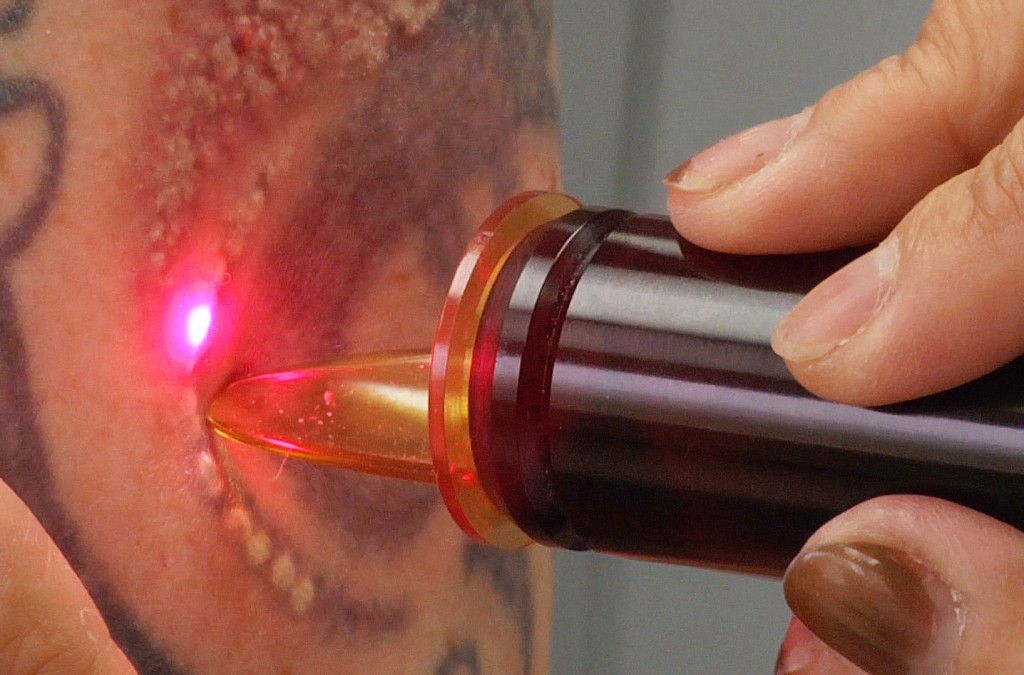Having posted a couple of replies on the Scalp Guru website recently in relation to somebodies concerns regarding understanding the whole ins and outs of scalp micropigmentation laser removal *
Here at Redeem Clinic we were carrying out laser tattoo remove* years before we expand our client services into scalp Tricopigmentation* and SMP services and not wanting to big ourselves up to much we have become somewhat experts in this field, offering ND Laser tattoo removal*, Ruby laser tattoo removal* as well as alternate Rejuvi tattoo removal services. Over the years we’ve seen clients with all forms of tattoos from standard Indian inks tattoos, full colour artistic tattoos, semi-permanent makeup tattoos as well as scalp micropigmentation laser removal* and therefore have a deep understanding of how pigments vary and consequently how results differ when treating them with laser.
The vast majority of Scalp micropigmentation and Scalp tattoos will use a dark coloured ink. Many people believe these inks to be single colour black inks, yet in the many cases this is not the case. This historically is where scalp micropigmentation and scalp tattooing have hit a problem when it comes to laser tattoo removal (there is no need to laser Tricopigmentation treatments). Many technicians rightfully choose a pigment that will match the clients natural hair pigment. In order to gain the various tones of pigment these inks need to be mixed with other colours to help give the tone (as per the example in the chart below).
We know over time that as well as the slight blurring / bleeding of effect of inks entered into the dermis layer using the traditional scalp micropigmentation techniques that often these inks will appear to have a blue / green tinge to them and in some cases a red tinge. As the scalp tattoo ages the ink particles tend to migrated a little over time, slightly increase in size and thus often end up showing the other pigments contained within the inks.
So what does this all mean in relation to laser tattoo removal for scalp-micropigmentation? Well simply put it often means the tattoo ink is not as easy to remove as some clinics would have you believe.
Firstly lasers can only remove certain colours. Some will tell you that lasers can remove all colours of pigment, yet to our knowledge and the physics behind current laser technology then this statement is entirely untrue. A company called Picosure recently made such claims about their laser yet allegedly the anecdotal evidence has proved this is not the case, so much so that alleged law suits have been brought against the company in relation to such claims. The picture below shows one of our recent clients that has had 6 sessions of laser with a Picosure machines and as can clearly be seen it has left the red, blues, green and yellows of the old tattoo.
The above said however, this doesn’t mean that the right lasers can’t remove scalp micropigmentation inks it just means it’s wise to know the laser which remove which inks. These are as follows:-
- ND Yag (Q switch lasers) can remove Black, Blue, Red and some brown pigments
- Ruby (Q switch lasers) can remove, Black, Blue and Green pigments
- Alexandrite lasers can remove can remove, Black, Blue and Green pigments
You will note that none of the above will remove yellow or white pigment, yet these pigments are often found in many inks used within the scalp micropigmentation industry.
So as we can be see that not all colours can be removed by laser and even though the above lasers can remove the vast majority of colours within scalp micropigmentation inks there comes other issues.
If the client has any green tinge pigments within their scalp inks then they will need to use a Ruby or Alexandrite laser to remove them. The lasers are fully capable of removing these pigments, yet should only be used on white skin types. Dark olive skin, Asian skin and black skin types treated with these lasers have a strong risk of hypopigmentation (where the melanin under the skin is destroyed leaving strong white pigment areas) and consequently should not be treated with laser.
With all forms of laser tattoo removal there comes trauma to the skin area treated, most of this is superficial, swelling, bleeding, bruising, blistering and will dissipate over a few days/weeks. This said however the long term risk of scaring is a very real one and naturally an unwanted consequence of some laser tattoo removal treatments. Industry risk show scaring as a result of laser tattoo removal to be found in 6% of clients, yet this is very much dependant on the knowledge and skill of the technician using the equipment. Also these industry figures relate to in general to standard tattoos and not scalp tattoos. The skin on our scalps tends to scar more easily, this is normally because the skin on the scalp and as such more susceptible to trauma.
The other thing we’re not often told by our laser tattoo removal technicians is that there are no guarantees that all the pigment can be removed in its entirety and if some cases not at all. In relation to the latter, some people are not suitable for laser tattoo removal treatment. When the ink is broken down by the laser it relies on the bodies immune system and blood flow to remove the micropigments created by the laser from within the tattoo area. Some peoples immune systems do not cope well with this process or will react negatively to the process, which can make the client unwell as well as resulting in none removal. Happy though most clients respond well and this is not an issue. However in some instances technicians will use semi permanent inks within scalp micropigmentation (not to be confused with Tricopigmentation inks which are different). These inks very often contain high levels of oxides within the pigment (designed to help the inks exfoliate in the epidermis layer of the skin and thus making them semi permanent) and when these pigments are zapped by the laser then the heat process incurred can actually fuse some of this pigment oxides together. If the latter happens then these pigments will stay permanently in the skin and can only be removed surgically.
Although lasers have been used with the scalp micropigmentation industry for almost 10 years the very vast majority of laser removal has only been seen in the past 18-24 months as the industry recognises that ‘helmet head’ (the primary results of too many top ups) has started to become an issue and also as some clients age they want to revert to a more age appropriate hair line. Within this same period the Chinese market has started to flood the industry with cheap ND Yag lasers. Add this to the fact that within the UK especially (and some other counties) that a new technician only needs to do the ‘core of knowledge’ course online (a 40 minute course) to qualify them to use a laser on clients then you can only imagine the issues this could cause a client. The advantage to the cheap Chinese ND Yag lasers is that due to their very low entry price into the market they tend on average to be low powered units and although therefore struggle with total pigment removal scaring risks can be reduced (when in fully qualified hands).
We then move to the realities involving the actual amount of time and money it takes to carry out laser tattoo removal. Although laser treatment prices have dropped dramatically in recent years (mainly due to the above mentioned factors) the average treatment in the UK for laser treatment is £20-£25 per square inch treated. Fine if it a small area, yet consider the price for a full scalp. Add to this that industry average for laser tattoo removal of pigments requires 11 treatments then this figure can soon become very high. Yes there seems to be a reality that scalp micropigmentation treatments need less laser treatments than the average tattoo due to the fact that in most cases the ink is not so concentrated or as deep within the skin, however there are no statistics for this within the industry so we can only work with known figures. We also need to remember that average are drawn from highs and lows and where one client may see removal within 3-4 treatments due to varying factors other will require 12-15. No technician regardless of their ability is able to advise a client of how many treatments will be needed to remove a certain persons tattoo due to the variables involved, type of ink, colours within in, depth and concentration of ink, strength of persons immune system etc. Generally a qualified laser tattoo removal technician will suggest at least 6 weeks between treatment meaning it can on average take at least a year to remove a tattoo. This is not great for any form of tattoo yet at least the vast majority of normal tattoos are covered with clothing during this period where as scalps are not, meaning a somewhat unsightly appearance for quite long periods of time.
For those who think I may be biased in relation to this article due to the fact that our clinics only perform Trico-pigmentation treatments that do not require the use of laser removal, I would simply say I’m firstly responding to a request from others to understand more in relation to the removal of SMP with lasers. Secondly for as little as £50 our clinics could start treating scalp micropigmentation, after all the majority of techniques are the same as Trico and we would only need to purchase a traditional tattoo gun (the £50) in order to carry out the treatments and in doing so broaden our clinics appeal, client base and income. The simple truth of the matter is we choose only to offer Trico due to many of the issues outlined in this article as well as various other long term concerns there are with SMP. So in short I suppose I am a little biased yet only with regards to placing the client first over and above our business revenues. We know reputation is everything and following the latter client first principles then I hope our business is still here in many years to come.
Mike Cherrington
Partner & Lead laser technician within Redeem Clinics
*Results may vary from person to person










 *
* *
*